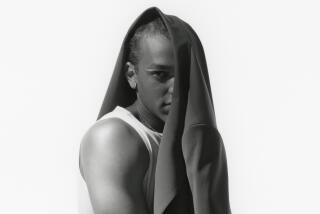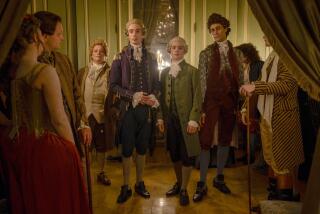Market Scene : Unkind Cut for London Tailors
- Share via
LONDON — The master tailors, fitters, cutters and the managing directors in and around a small Central London street called Savile Row believe deeply that what is best about Britain is epitomized by a well-made suit.
For generations, a custom-made Savile Row suit separated a gentleman from the pack--and marked its wearer as a person of taste, style and discernment.
As Angus H. Cundey, director of Henry Poole & Co., Savile Row’s oldest tailoring house, puts it: “A Savile Row suit is made for you, quietly elegant. A ready-to-wear suit is made for someone else.”
But in recent years--partly due to the recession and partly because of the fashion for Continental-style, unstructured men’s clothing--Savile Row has faced a crisis of dangerously falling sales.
Now, it has begun to fight back. The old Savile Row houses are banding together in a publicity campaign extolling the virtues of buying a custom-made suit that will always be correct, and that will reputedly last at least 10 years.
As publicist Anthony Edwards puts it: “Designer clothing is to show that you are rich and famous. It has a short life span. Savile Row suits say, ‘I am a gentleman.’ We think the mid-1990s will find a swing back to quality tailoring--value for money.”
And one famous firm, Bernard Weatherill, has launched a women’s department that Managing Director Hugh Holland calls “an exciting new concept intended to allow women customers to design the perfect garment from a range of different styles.”
Weatherill boasts Royal Appointments to the Queen and Queen Mother, and has had Jacqueline Onassis among its clients.
In defending “bespoke”--Americans say “custom”--tailoring, Savile Row, some commentators contend, means much more than a good suit. It means nothing less than that which is best about the entire British way of life.
Declares John Taylor, editor of British Style magazine: “The Savile Row suit is restrained. It’s about discipline, about self-discipline perhaps. Once discipline goes, the whole social structure goes.”
And Sir Hardy Amies, who runs a Savile Row firm under his name, adds: “It is clear that the man’s suit--an English invention, I must add--is still worn by men at all times when respect for tradition and hope for an ordered future prevail.”
The male English sartorial style began with George Bryan (Beau) Brummell, the well-known dandy at the beginning of the 19th Century. Henry Poole & Co. was founded around the same time (1806), originally as a military tailor. Later, it went into business on Savile Row.
Poole became tailor to the Prince of Wales, later King Edward VII, and his premises were more like a private club than a shop--with prominent customers dropping by to drink claret and smoke cigars.
In 1860, Poole made a short smoking jacket for the Prince of Wales, and a similar one was made for a visiting American, James Potter of Tuxedo Park, N.Y., who introduced it at the Tuxedo Park Club. That’s why the dinner jacket is known as a tuxedo in America.
Poole’s customers included J. P. Morgan, Prince Otto von Bismarck, Charles Dickens, William Randolph Hearst, Sir Winston Churchill, Charles de Gaulle and Emperor Haile Selassie of Ethiopia.
Today, a large percentage of Poole & Co.’s sales--like those of many other Savile Row firms--are made to American customers. Poole executives, for instance, make twice-yearly trips to the United States.
The most daunting aspect of a bespoke suit is its price: Two-piece business suits in quality worsteds run from about $1,700 to $2,700. Cashmere and special fabrics are higher.
“The price may seem high,” says Weatherill’s Holland. “But we have to pay our finest tailors high salaries to keep them.”
Holland and Peter Ferguson-Smith of the Kilgour, French & Stanbury firm say most of their customers are middle-aged, and the first suit may take four or five fittings; later the customer’s pattern is kept on file, and the suits are ready with fewer fittings.
“After 50, the human body goes into genteel decline,” says Ferguson-Smith. “If a man is short and fat, we try to make him long and thin--with proper fabrics, cut and line.”
Further, Savile Row tailors never call attention to their labels. “The label is placed upside down inside a breast pocket--to identify you in case of drowning,” cracks one tailor.
Most Savile Row tailors are discreet about their clients.
Poole’s Cundey says: “Unless I have their permission, I do not mention any living customer, and anything that’s told to us we treat in full confidence.”
But Douglas Hayward, another high-priced tailor and one with many show business customers, lets it be known that his clientele includes Roger and Dudley Moore, Michael Caine, Sir Alec Guinness, Sir Andrew Lloyd Webber, Kirk Douglas, and Charlton Heston.
Some Londoners and visitors have found good buys in what might be called “Off-Savile Row”--nearby shops with fine-quality materials and good tailors that can produce suits at half the price of a fancy Savile Row suit.
“We do all handwork but at competitive prices,” says Joseph Ghazal, proprietor of Regent’s in Regent Street. “We have a lot of foreign customers who seem to be satisfied. If you don’t please the customers, they don’t come back. Our business has held up pretty well despite the recession.”
The recession hit Savile Row hard, as did the Lloyds of London losses suffered by customers. To cut costs, some firms have merged and consolidated under single managements, like Bernard Weatherill and Kilgour.
Many firms think the worst is now behind them. However, true to their tradition of discretion, sales figures are never made public. (Robert Bright, of the Federation of Merchant Tailors, estimates that there are about 40 bespoke tailors left in the Savile Row-Central London area and that they make about 25,000 suits a year for about $50 million in sales.)
“In the last half of 1993, there has been a definite improvement,” says Colin Hammick, managing director of H Huntsman. “If our prices have remained high, it is because we do not want to dilute our product simply to reduce the price.”
And Poole’s Cundey observes: “The recession was worse for us than the 1930s. Luckily, our overseas orders mainly held up, though the American market was depressed. Next year, I think more people will want the classic English look, less laid back, rather than the baggy Italian one.”
What Poole’s Cundey would like most to see is a return to graceful dressing among British businessmen--and particularly politicians.
“It’s a sad fact,” he said, “that the Englishman is no longer the best dressed man in the world. It’s a disgrace the way some of our ministers look, a national tragedy the way MPs (members of Parliament) dress.
“We want to get Englishmen to wear bespoke suits. We want to bring back the elegance in dress the Englishman was once noted for.”
More to Read
Sign up for Essential California
The most important California stories and recommendations in your inbox every morning.
You may occasionally receive promotional content from the Los Angeles Times.













